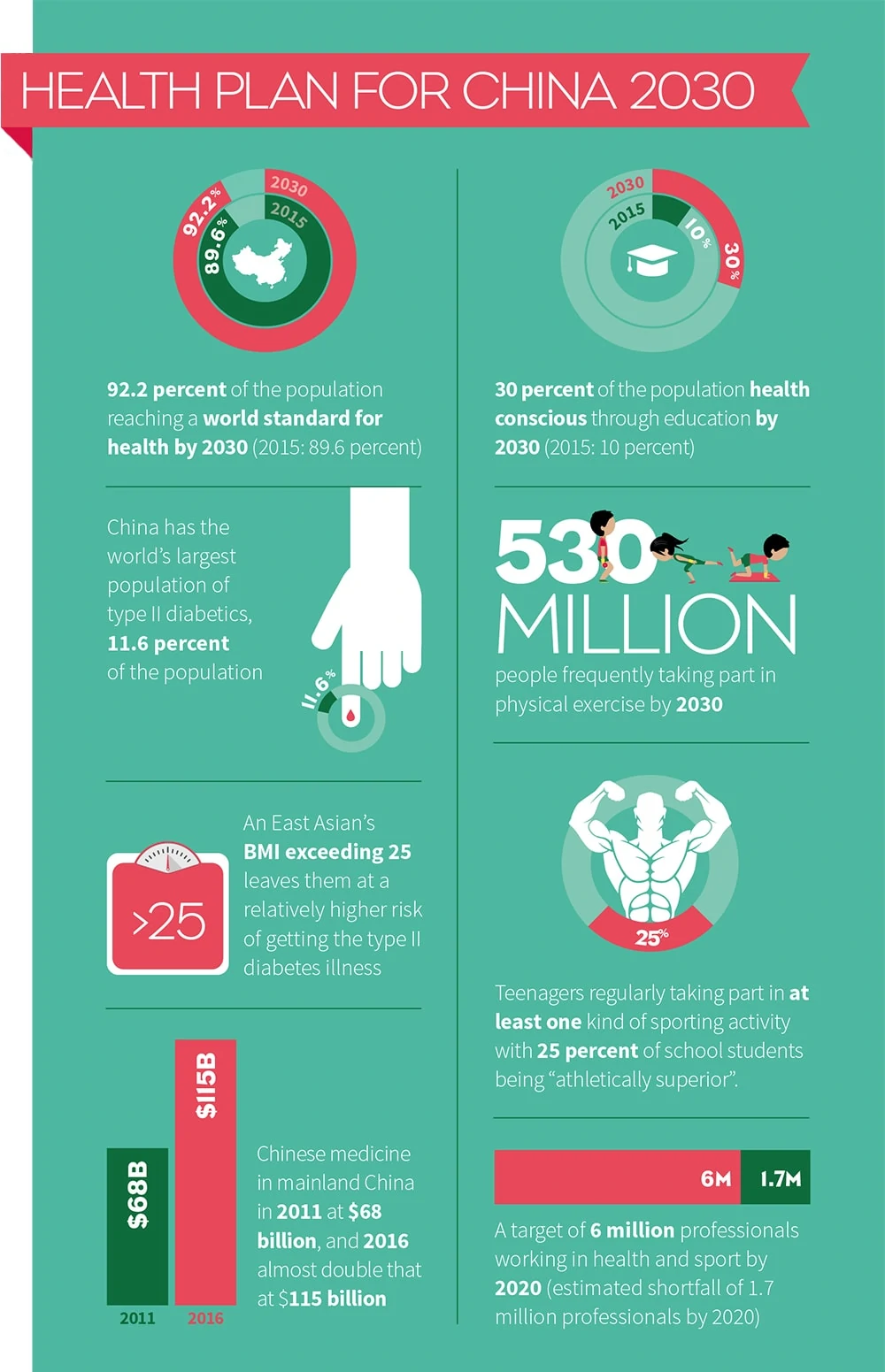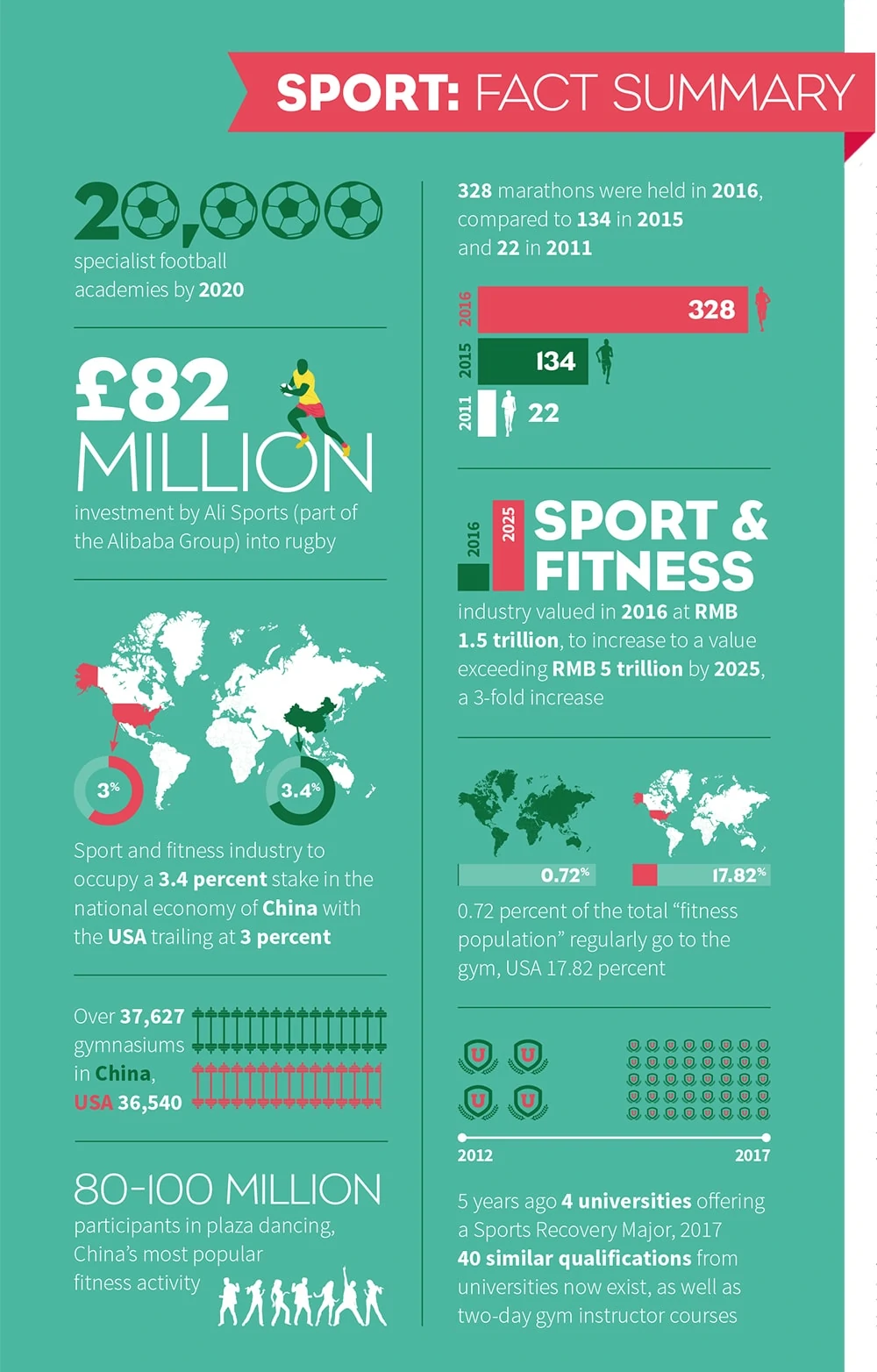A healthy policy for a healthy nation
President Xi Jinping stated at the China Health Assembly last year that: “without a healthy society, there will be no wealth in society at all.” This statement gave the CPC Central Committee the mandate to make ‘Health Plan for China 2030’ a national policy. The nature of this policy has been largely overshadowed by other giant initiatives such as the ‘Belt and Road Initiative’ and the ‘Made In China 2025’ campaign. Although the figures associated with these campaigns are huge, the numbers for the Health Plan for China 2030 are also colossal. And we know that in China, when those in charge want something to happen, it usually does.
The health policy has highlighted a number of key objectives for 2030, such as: 92.2 percent of the population should reach a world standard for health (up from 89.6 percent in 2015); making 30 percent of the population health conscious through education (up from 10 percent in 2015); and decreasing the growing population of type II diabetics within China, now the world’s largest after the American Medical Association’s most comprehensive study placed the figure at 11.6 percent.
The Health Plan for China 2030 stresses a healthy society is crucial to economic development
The sportier the better
In much the same way as Europe and America has done in the past, China is starting to focus more of its attention to sport. The health policy aims to get 530 million people frequently taking part in physical exercise with teenagers regularly taking part in at least one kind of sporting activity and 25 percent of school students being “athletically superior” by 2030.
The plan for sport is already underway. The most well known aspect of this plan is football, as announced in the 13th five-year plan; it aims to have 20,000 specialist football academies by 2020. Private business has seen this as an opportunity to “score abroad”, most evident in the wave of Chinese buying up foreign football clubs and players, with the most recent being Landa Sport Development taking what is believed to be an 80 percent share in Southampton Football Club. However, away from football, there is a much broader buzz around sport and fitness.
As an example, in 2016 the General Administration of Sport in China stated 328 marathons were held in that year, compared to 134 in 2015 and 22 in 2011. We also know that Alisports (part of the Alibaba Group) are investing £82 million into rugby in China, as well as working with the actor Jet Li and Healthmail to launch a major MMA (Mixed Marshal Arts) competition in Shanghai in October of this year.
As announced in the document, “Some State Council Recommendations for the Development of the Sport and Fitness Sector”, there is an economic goal of taking the current value of the sport and fitness industry from its 2016 valuation of RMB 1.5 trillion to over RMB 5 trillion by 2025 – more than a three-fold increase.
The sports economy in China is indeed a “gold mine”
According to The Economist Intelligence Unit, that will occupy a 3.4 percent stake in the national economy of China, with the USA trailing at 3 percent. Relative to the current economic underpinnings of the economy and consumption rate (13 percent of the world), analysts see the figures as being no castle in the sky.
Private business has been quick to act. There has been a dramatic adoption of western style sports and fitness regimes in the last five years. According to a consultancy firm in the health and fitness sector in China, SAAS, there are now over 37,627 gymnasiums in China (in comparison, the USA has 36,540). But this also suggests other significant variables to add to the mix, namely quality and culture. Is it really possible for an industry that has developed within the last five to ten years to present greater opportunity than in western countries? That is a topic of hot debate in China.
Quality care, deep culture
A lot of Chinese culture stems from Confucius, who emphasised that the teacher is the source of knowledge, which explains the relatively high reputation of a teacher in China. This also perhaps explains the popularity of class fitness sessions, such as Yoga and Pilates, and the much lower participation rate of those going to the gym for an individual workout which, in the same paper published by SAAS is only 0.72 percent of the total “fitness population”, compared to the USA’s 17.82 percent.
One reason for the low rate is quality and understanding, as well as trust. The number of those with significant understanding of health and fitness in China is small in comparison to western countries, which leaves little opportunity for those wanting to get fit under professional guidance. For instance, Sports Recovery is still a relatively fresh, if not clearly defined, area of study in China. Encompassing physical, occupational and speech therapy and lacking clear differentiation between them, Beijing Sports University was one of only four universities to offer a major in the discipline five years ago whereas today, forty similar qualifications from universities now exist, as well as the two-day gym instructor course, which is now on offer in plenty of places in China.
There are some companies and start-ups taking advantage of the more scientific and quality assured class-based fitness programmes. Founded by Americans Derrick and Kelly Cope, Synapse Pilates was the first Pilates school in China that offered training to those wanting to become Pilates teachers. With its American brand and industry champion teacher, Synapse offers one of the few fitness qualifications with a good reputation in China. Derrick says “the increase in students taking the course within the last four years has far outpaced the ten years previously.”
There has been a dramatic adoption of western style sports and fitness regimes in the last five years
A new start-up, Wellness in Sport, is also targeting the estimated 1.7 million shortfall in professional trainers the government has highlighted as an obstacle to the industry’s development (a target of 6 million professionals by 2020 as proposed in the 13th five-year plan). They provide a Sports Science centre that combines Western and Chinese medicine as well as qualified doctors to provide reassurance and precision, something that has long been lacking in the Chinese fitness market. In mainland China, from the gym to the sports recovery hospital, the industry is very much dominated by people from the West or Hong Kong. Just as British excellence in health care has been recognised by the Chinese, so is the same feeling starting to trickle down to sport.
There are also a number of lifestyle sports that dominate the Chinese market that we are unfamiliar with in the West. Guangchangwu or plaza dancing is arguably the most popular form of fitness exercise in China where 80-100 million, mainly middle-aged and elderly, Chinese enthusiastically join in. Business also benefits from the popularity of the dancing, with phone apps such as Tangdou and 999d.com supplying everything from digital platforms to music and clothing for the dancing divas. According to Touzi Zai Xian, a Chinese investment news website, Tangdou had taken a total of £15 million during it’s A and B round of venture capital funding in under a year.
Giving it the right medicine
As a country with arguably the longest lasting independent culture in the world, China is immensely proud of its heritage. When it comes to health, there are usually two options which are considered: Western or Chinese medicine. The latter market has seen exponential growth in recent years, with a report published by Euromonitor, a market research consultancy, stating that the value of Chinese medicine in mainland China in 2011 was £50 billion, and by 2016 had increased by over 66 percent to £88 billion. But in sport and physiotherapy, it has always been western medicine that has dominated, something the government has picked up on, and in the Health Policy for China 2030, Chinese Martial Arts have been given a Five-year Development Plan, that incorporates Wu Yi or martial arts medicine.
Bai Yi Yuan, a health management company run by Ms Hu in Jiangsu Province and entering a new stage of expansion, has created a concept that utilises Wu Yi, as well as other forms of Chinese medicine, which Chinese people often find easier to relate to than the new forms of recovery and health management that have sprung up over the past 10 years.
Lucy Yan, a ohysiotherapist at Circle Harmony Health says, “Chinese medicine is an important part of rehabilitation in China which might not yet be considered physiotherapy. Western medicine is well known for its precision, but it is difficult to deny the effectiveness of Chinese medicine”.
Finding the balance, like Yin and Yang
When considering the economic underpinnings and helping hand of the government, there is strong evidence to suggest that the sports economy in China is indeed a “gold mine”, as was suggested by the Chinese ambassador to the UK, Liu Xiaoming. The evidence suggests that the key to the market place is to articulate business models in sport and fitness in such a way that not only is health emphasised, but also Chinese culture itself. This is precisely the motive of Health Plan for China 2030, which in its stress on how a healthy society is crucial to economic development, places equal emphasis on both Western and Chinese style healthy living.
Britain has a distinct advantage in sport and health with its knowledge and the skill set that provides quality to the industry, but a balance needs to be found where the best of the West can incorporate those aspects of culture the Chinese attach importance to.




